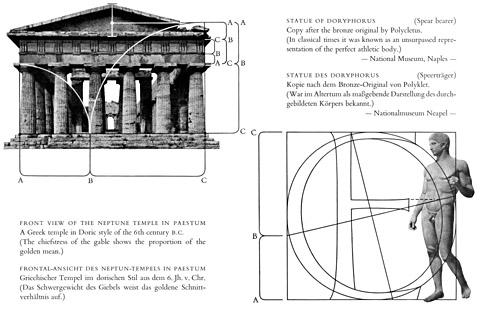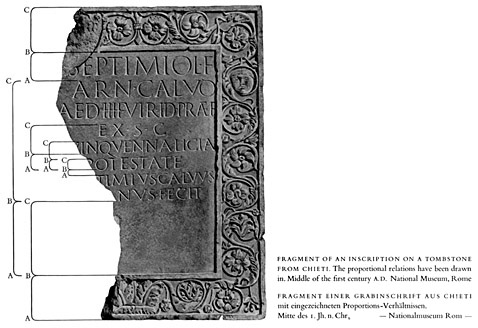|
|
|
PROPORTION IN NATURE AND IN ART
Proportions and phenomena in nature influence the fine arts of all times. That which the artist realises in his work is not, however, the copy of nature in itself, but its law of structure. Rhythm and proportion as laws of nature are also contained in lettering and turn it into an artistic form of expression. In contrast to this, geometry represents the law of structure of lifeless matter, which consequently stands in no direct relation to art.
The phenomena of proportion as expressed in the measurements of the human body, in the distance between the rows of branches in a young fir tree, which taper to the top, in the measurements of the egg shape, or in the spiral of a snail-shell, to mention a few examples, always reveal the proportions of the golden mean. Natural phenomena were already recognised by the Greeks and by the peoples of still earlier periods and were naturally used in their art. Out of this recognition arose the ideal human body as portrayed in Greek sculpture. Harmonious results were obtained in ancient pottery where the golden mean was applied, and Greek buildings in their major as in their minor parts bear the aforesaid proportions (see page 65).
 Later researches in aesthetics in nature and in art affirmed proportional relations for both, this relation being represented by the proportional numerals 1, 2, 3, 5, 8, 13, 21, 3 4, 5 5, 89, and 144... (Zeysing 1855 and Ghyka 1927). The corresponding definition of the golden mean is: "The division of a distance (or a mass) into two parts, the lesser of which is to greater as the greater is to the whole."
He who sees and thinks in terms of proportion acts clearly and therefore it can only be useful in our age to know about these things. On the other hand it must be said that the phenomena of proportion exist in nature without the help of aesthetic research. The artist acts above all emotionally, and when he finds the harmonious effect of the proportion of the golden mean, while correcting his work, he does not take the result as being a scientific perception. For the rhythmic law lives in him, since he too is a part of nature.
Later researches in aesthetics in nature and in art affirmed proportional relations for both, this relation being represented by the proportional numerals 1, 2, 3, 5, 8, 13, 21, 3 4, 5 5, 89, and 144... (Zeysing 1855 and Ghyka 1927). The corresponding definition of the golden mean is: "The division of a distance (or a mass) into two parts, the lesser of which is to greater as the greater is to the whole."
He who sees and thinks in terms of proportion acts clearly and therefore it can only be useful in our age to know about these things. On the other hand it must be said that the phenomena of proportion exist in nature without the help of aesthetic research. The artist acts above all emotionally, and when he finds the harmonious effect of the proportion of the golden mean, while correcting his work, he does not take the result as being a scientific perception. For the rhythmic law lives in him, since he too is a part of nature.
 Walter Kaech, Rhythm And Proportion In Lettering [Rhythmus Und Proportion In Der Schrift] Olten Und Freiburg Im Breisgau : Walter-Verlag. Copyright Otto Walter Ltd., Olten (Schweiz), 1956.
Walter Kaech, Rhythm And Proportion In Lettering [Rhythmus Und Proportion In Der Schrift] Olten Und Freiburg Im Breisgau : Walter-Verlag. Copyright Otto Walter Ltd., Olten (Schweiz), 1956.
|
|